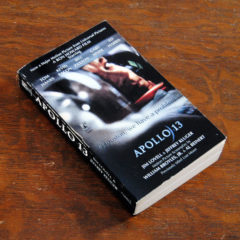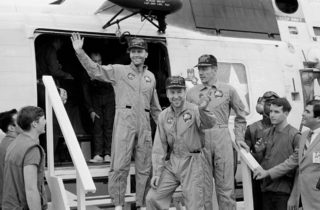
Around the time that the film adaptation of Lost Moon, called Apollo 13 came out, my parents who knew I was in love with all things NASA bought me the book by Jim Lovell and Jeffrey Kluger.
The book, in a concerted marketing effort with the movie was also retitled from Lost Moon to Apollo 13 and with a picture of not Lovell but Tom Hanks as Lovell on the front cover. And while I read the book, or read through it when I picked it up recently, I now had the knowledge of the other books I’ve been reading; First Man, Return to Earth, Carrying the Fire, and Failure is Not An Option.
One of the things that is most interesting about reading so much about one subject is that you get to see what the whole tapestry is. You seem to feel like you get a larger picture as things develop. Some details are new, some are redundant, some are omitted altogether.
What this means, is that whatever my younger self thought of this book, my current self was in love with the parts of it that I either don’t remember from the movie and or were left out of the other books.
And while this book does go back and forth from Lovell’s biography, details that are left out of the other mentions of Apollo 13’s mission from the other books and from the movie are some of the most amazing details.
There were three burns that could have brought them home faster on the free return trajectory slingshot around the moon. They choose the slowest of them, for good reason, but this book dives into what those three options were and who was in the room to make the decisions.

This is mentioned in the author’s notes. “Like many nonfiction books of this kind, one of the authors was also one of the participants in the history being recounted; unlike many books of this kind, Lost Moon is written in the third person. Had the key events of the Apollo 13 mission taken place exclusively in the spacecraft, a first-person account, in the singularly well-informed voice of the commander of the mission, would have made the most narrative sense. But as the men and women who were involved in the flight uniformly agree, the tale of Apollo 13 was one with many venues. For this reason, we have tried to take the reader to as many of those places as possible–newsrooms, conference rooms, homes, hotels, factories, naval vessels, offices, ready rooms, laboratories, and of course Mission Control and the spacecraft themselves. To achieve this kind of omniscient sweep, the third-person voice seemed the only way to go.”
And getting to know the players and the discussions of options is part of what makes this book compelling beyond the “Houston, we have a problem” part of the book.
The successful return of Apollo 13 was an engineering feat that is astounding. The tonnage of if-then statements that were either tried during a mission or in a simulation that NASA held on to for future use that was utilized during 13 is a lot for sure.
But here are the highlights from this book that I found most astonishing, in light of the fact that on a whole, the story as a whole, is incredible.
Lovell chose the name Odyssey for the Command Module “because he just plain liked the ring of the word, and because the dictionary defined it as “a long voyage marked by many changes of fortune”–though he preferred to leave off the last part.” This seems more poignant now, but if the flight had been nominal, this wouldn’t seem like anything but a random factoid.

AS13-59-8500A (17 April 1970) — This view of the severely damaged Apollo 13 Service Module (SM) was photographed from the Lunar Module/Command Module (LM/CM) following SM jettisoning. As seen in this cropped image, enlarged to provide a close-up view of the damaged area, an entire panel on the SM was blown away by the apparent explosion of oxygen tank number two located in Sector 4 of the SM. Two of the three fuel cells are visible just forward (above) the heavily damaged area. Three fuel cells, two oxygen tanks, and two hydrogen tanks are located in Sector 4. The damaged area is located above the S-Band high gain antenna. Nearest the camera is the Service Propulsion System (SPS) engine and nozzle. The damage to the SM caused the Apollo 13 crew members to use the LM as a “lifeboat”. The LM was jettisoned just prior to Earth re-entry by the CM. Photo credit: NASA
For all the success that Lovell had in space, he did make one gaffe with a hot mic during the Apollo 13 mission. “‘Freddo,’ Lovell said, turning to Haise, ‘I’m afraid this is going to be the last moon mission for a long time.’” And with a hot mic, everyone in Mission Control and anyone else who was listening heard that. And while you can’t blame a Commander who’s ship is busted as he goes around the moon for his thoughts, NASA for all its good public relations had trouble with this narrative. Still, it’s hard to put this all on Lovell. Thankfully, this didn’t make it into the movie.
But those in Mission Control, especially those under Gene Kranz leadership were moved from their rotation in front of their consoles to become part of the Tiger Team that would spend most of the time problem solving, coming back on console only for major events in the flight. Otherwise, they were in room 210.
“In principle, every man in room 210 understood that engineering corners would have to be cut if the command module was going to make it home intact. In practice, however, nobody wanted to think that it would be his corner that would be affected…”
In this regard, John Aaron and Gene Kranz did the brunt of the negotiating and decision making. Which by all accounts might have been one of the hardest things either man had ever done.
Apollo 13 or Lost Moon as it was originally titled also told the narrative of the wives with more detail than any other book I’ve read about the Apollo era. Specifically, “one of the most important things an astronaut’s wife needed to remember during the course of a flight was how to ration her reactions. Though the networks could afford to dramatize every tweak of a thruster or torque of a platform for the TV audience, the people whose fathers and husbands and sons were riding inside the spacecraft did not have that freedom. For them, the flight wasn’t national news; it was, in the most literal sense, domestic news. It wasn’t the future of the nation that rode on the outcome, but the future of the household. With stakes that high, the wives, at least, could not afford the luxury of a fully emotional response at each critical turning point.”
But the two most incredible things from this book belong to the nuclear reactor that was aboard Apollo 13 and a sheet of paper with $312,421.24 on it.
Yes, the first thing I just mentioned, Apollo 13 had a miniature nuclear reactor aboard. “Since the experiments were intended to operate for well over a year, and since fuel cells or batteries could not keep them running that long, the equipment was instead powered by a miniature nuclear reactor, fueled by spent uranium taken from nuclear power plants.” This meant that when Odyssey was headed back to Earth with Aquarius (the Lunar Module or LEM) still attached, the Atomic Energy Commission (AEC) wanted to make sure the LEM would not cause any harm, so while it was cause for salvation for the three astronauts aboard who used it as a lifeboat, it was not something the AEC was looking forward to seeing again.
But it wasn’t all doom and gloom and this book is a testament to the fact that engineers do in fact have a sense of humor and $312,421.24 when I read its explanation made me laugh.

n the first line of the form, underneath the column headed “Description of Services Provided,” someone had typed “Towing. $4.00 first mile. $1.00 each additional mile. Total charge, $400,001.00.” On the second line, the entry read: “Battery charge, road call. Customer’s jumper cables. Total $4.05.” The entry on the third line: “Oxygen at $10.00/lb. Total, $500.00.” The fourth line said: “Sleeping accommodations for 2, no TV, air conditioned, with radio. Modified American Plan with view. Prepaid. (Additional guest in room at $8.00/night.”
The subsequent lines included incidental charges for water, baggage handling, and gratuities, all of which, after a 20 percent government discount, came to $312,421.24.”
I don’t know if this bill was ever sent and while I’m sure North American Rockwell wouldn’t have taken too kindly to it at the time, in hindsight, it seems like a way to let off some steam in a good-natured way. A kind of ribbing if you will between companies, who were both excited that Apollo 13 returned to earth.
So, the original title for the book was Lost Moon, but it was retitled Apollo 13 when the movie that was based on it came out, but no matter which title you find online or at your local book store find the book written by Jim Lovell and Jeffrey Kluger because it is a fantastic read.
Read the Secret File of technical information and quotes from Lost Moon retitled Apollo 13.